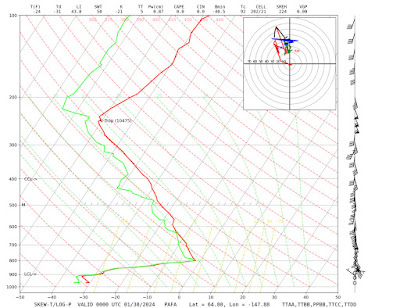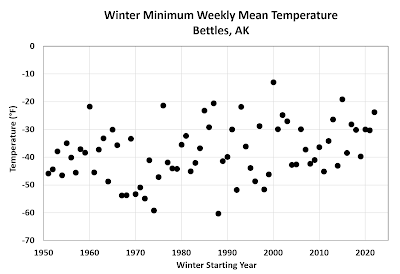[Hat-tip to Brian Brettschneider for pointing out the event discussed below.]
Yesterday I highlighted the strong southerly flow across central and eastern Alaska that raised temperatures aloft up to near the freezing point above Fairbanks. Elevated locations in the Yukon-Tanana uplands and the Alaska Range experienced this warmth directly: take a look at yesterday's high temperatures between Delta Junction and Glennallen (click to enlarge).
An automated site just above 5000' elevation (Look Eyrie) overlooking Isabel Pass (3600') rose to 36°F around noon:
But below about 3000' on the north side of the Alaska Range, the warmth didn't break through. Here's the chart for a site at 2430' (Black Rapids Chalet) just to the north of the Richardson Highway pass: notice the high temperature of -17°F yesterday.
In the roughly 10 miles and 1000' elevation between this site and the pass, the back-and-forth "slosh" of the dense surface cold air produced remarkable swings in temperature yesterday evening. The following chart is from the Black Rapids FAA site less than 2 miles up the road, and just 250' higher:
Check out the alternating wind direction and temperatures between 9pm and midnight (click to enlarge):
Warm air broke through 3 separate times, with the temperature dropping back to -10°F or lower between each episode! Then finally the cold northerly flow won out by midnight, and the temperature re-stabilized below -20°F, with quite a wind chill (wind speed up to 35mph).
Up at the pass, a single warm episode occurred, with the temperature holding not far below freezing for more than 5 hours in a southerly breeze; then the wind reversed and the temperature dropped an amazing 42°F in 10 minutes. In reality one can imagine the temperature drop being almost instantaneous as the boundary passed: air masses of such different density are nearly immiscible, like oil and water - hardly mixing at all.
Similar events occurred about 15 miles to the south, at Fielding Lake (elevation 3000'):
Here's the surface/MSLP analysis at 3pm, courtesy of Environment Canada.
Low pressure was pushing up from the Gulf (producing another big snowfall in Anchorage), and the impulse associated with this storm is what drove the temporary warm air intrusion across the higher elevations.
What an interesting meteorological event!





















































